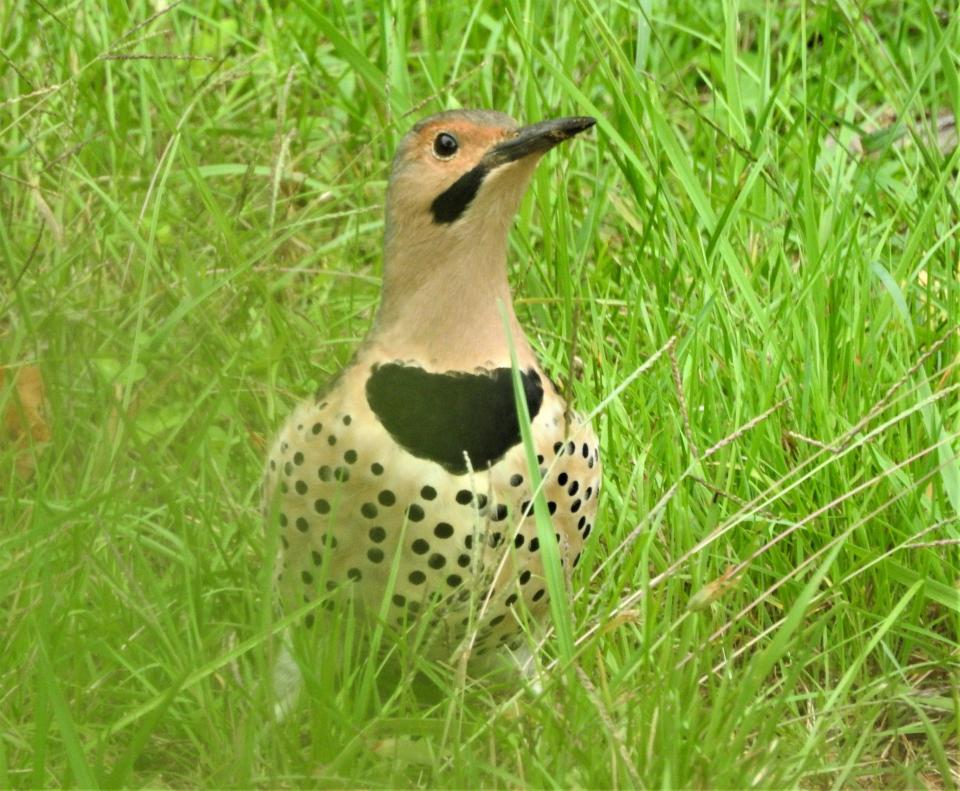Nature News: Northern flickers like having ants in their ... feathers?
My yard must be one of the most exciting places for northern flickers. These large, brown woodpeckers don’t do much hunting, hammering on trees and dead wood like most woodpeckers. Instead they go after two of their favorites, ants and beetles, on the ground.
Their beaks are big and powerful like most woodpeckers, but have a slight downward curve, more useful for digging in the ground. They use their extra-long, extra-sticky (they have a large salivary gland that produces exceptionally sticky saliva) barbed tongues to lap up any ants that they dig up. According to the American Bird Conservancy, one flicker's stomach was found to contain more than 5,000 ants!

Flickers also share a really interesting behavior with common grackles and many other bird species in that they don’t just eat ants. Sometimes they will allow ants to crawl all over and among their feathers. The ants secrete formic acid which helps repel lice and other parasites. This is called passive anting. Flickers will also engage in active anting where they rub the ants through their feathers as they preen.
More: Welcome the goldenrod this fall instead of fearing it. It's not what's making you sneeze.
Three male flickers have been hanging out in the field next to my house, spending all the time they are not looking up to check for predators, with their heads buried in the sandy, sparsely vegetated soil. I can’t quite see what they are getting, but I’m going to assume ants, primarily because we have so many ant holes. I can tell these are males because they have what is called a black "mustache" on either side of their bill. That’s the only obvious difference between males and females – females do not have black mustaches.
Northern flickers are brownish all over with a bright red "V" on the nape of their neck, black spots and a very obvious white rump patch. If I can’t get a good look, I can always be fairly sure I’m seeing a flicker if I see that white rump patch.

While they don’t generally use their beaks to bore into wood to get prey, they do use them for communication and to defend territory. They’ll often find the loudest thing available to hammer on, anything, metal works really well. According to Cornell Labs All About Birds (www.allaboutbirds.org), a northern flicker in Wyoming could be heard drumming on an abandoned tractor from a half-mile away!
Back when I was a kid, the northern flicker was broken up into two species: the western red-shafted flicker and the eastern yellow-shafted flicker. I really loved the plate in my old Peterson’s guide. There was something so exotic about that flash of yellow when you watch a flicker fly by. When I moved out west, I felt the same about that flash of red. More recently these two color variations have been combined into one species - the northern flicker.
More: Nature News: Rare northern blazing stars found in abundance on Maine's Kennebunk Plains
These two types of birds have nearly identical DNA, differing in only 0.01% of their genome, but those different genes matter, since they are what lead to the red or the yellow shaft. This was discovered recently when Stephanie Aguillon, a PhD candidate in the Fuller Evolutionary Biology program at the Cornell Lab of Ornithology, sequenced the entire flicker genome and identified the genes responsible for the color differences. One of those genes is the same one that accounts for color variation in canaries and zebra finches. Yellow and red-shafted flickers can interbreed where their range overlaps resulting in fertile hybrids that can have traits of both parents with different shades of orange - from yellowish orange to a red orange - under their wings. So, it really doesn’t make biological sense to consider these separate species.

Northern flickers have the most widespread range of any North American woodpecker, found from the northern extent of the treeline up in Alaska and Northern Canada, south into Central America. The northern flickers dwelling in the north are migratory. Around here, they are year-round residents. You are more likely to see them around a bird feeder. They like suet, black oil sunflower and nyjer seeds) though they are rarely found on the bird feeder itself, preferring to forage on the ground. Their diet also includes more berries in the winter. One winter, I watched a flock of flickers descend on some robustly growing poison ivy and strip it clean of its berries.
In addition to being widespread, they are fairly common. Easy to recognize, even their call is fairly obvious. They get their name from their squeaky “flick-a flick-a flick-a” call. The call I find easiest to identify is their loud, evenly-pitched “wick wick wick wick wick.”
Northern flickers are a great bird to get to know. I really feel like we have too many ants so I am always more than happy that flickers are here to help balance out the numbers.

Susan Pike, a researcher and an environmental sciences and biology teacher at Dover High School, welcomes your ideas for future column topics. Send your photos and observations to spike3116@gmail.com. Read more of her Nature News columns online at Seacoastonline.com and pikes-hikes.com, and follow her on Instagram @pikeshikes.
This article originally appeared on Portsmouth Herald: Nature News: Northern flickers like having ants in their ... feathers?

